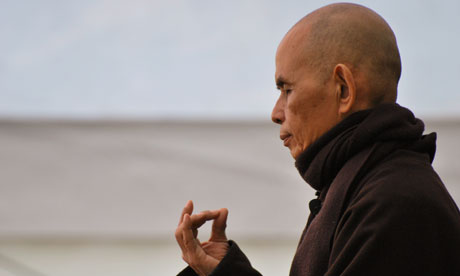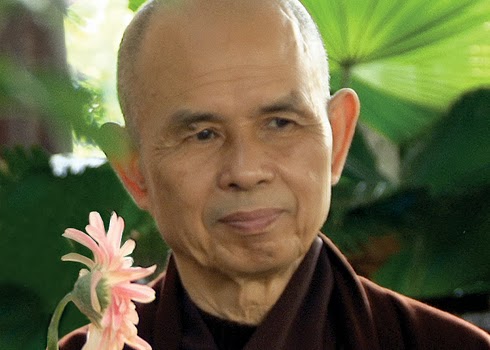Breathing and Being Peace with Thích Nhat Hanh
"Feelings come and go like clouds in a windy sky. Conscious breathing is my anchor.”-- Thích Nhat Hanh
 Thích Nhat Hanh (born October 11, 1926) is a Vietnamese Zen Buddhist monk, teacher, author, poet and peace activist. He lives in the Plum Village Monastery in the Dordogne region in the South of France, traveling internationally to give retreats and talks.
Thích Nhat Hanh (born October 11, 1926) is a Vietnamese Zen Buddhist monk, teacher, author, poet and peace activist. He lives in the Plum Village Monastery in the Dordogne region in the South of France, traveling internationally to give retreats and talks.
I witnessed one of his talks at the Riverside Cathedral in New York, just after September 11th, 2001. I can that say without question he is the living embodiment of his teaching.
Here is an excerpt from the book, Being Peace by Thích Nhat Hanh:
"From time to time, to remind ourselves to relax, to be peaceful, we may wish to set aside some time for a retreat, a day of mindfulness, when we can walk slowly, smile, drink tea with a friend, enjoy being together as if we are the happiest people on Earth. This is not a retreat, it is a treat. During walking meditation, during kitchen and garden work, during sitting meditation, all day long, we can practice smiling. At first you may find it difficult to smile, and we have to think about why. Smiling means that we are ourselves, that we have sovereignty over ourselves, that we are not drowned into forgetfulness. This kind of smile can be seen on the faces of Buddhas and bodisattvas.
"I would like to offer one short poem you can recite from time to time, while breathing and smiling.
Breathing in, I calm my body. Breathing out, I smile. Dwelling in the present moment I know this is a wonderful moment.
" 'Breathing in, I calm my body.' This line is like drinking a glass of ice water-you feel the cold, the freshness, permeate your body. When I breathe in and recite this line, I actually feel the breathing calming my body, calming my mind.
" 'Breathing out, I smile.' You know the effect of a smile. A smile can relax hundreds of muscles in your face, and relax your nervous system. A smile makes you master of yourself. That is why the Buddhas and the bodhisattvas are always smiling. When you smile, you realize the wonder of the smile.
" 'Dwelling in the present moment.' While I sit here, I don't think of somewhere else, of the future or the past. I sit here, and I know where I am. This is very important. We tend be alive in the future, not now. We say, 'Wait until I finish school and get my Ph.D. degree, and then I will be really alive.' When we have it, and it's not easy to get, we say to ourselves, 'I have to wait until I have a job in order to be really alive.' And then after the job, a car. After the car, a house. We are not capable of being alive in the present moment. We tend to postpone being alive to the future, the distant future, we don't know when. Now is not the moment to be alive. We may never be alive at all in our entire life. Therefore the technique, if we have to speak of a technique, is to be in the present moment, to be aware that we are here and now, and the only moment to be alive is the present moment.
" 'I know this is a wonderful moment.' This is the only moment that is real. To be here and now, and enjoy the present moment is our most wonderful task. 'Calming, Smiling, Present moment, Wonderful moment.' I hope you will try it."
(This is an Excerpt from the book, Being Peace, by Thích Nhat Hanh. From Spirituality & Practice.)
The Breath is the Way

Some time ago I was listening to a talk by Thich in which he shared some very powerful truths in his signature direct, peace-filled way. I compiled some of these in a post here:
The Energy of Mindfulness - with Thich Nhat Hanh
This is once of my favorites:
Between the body and the mind there's something else that links the two things, that is our breathing. When we touch our breathing -- "Breathing in, I know I'm breathing in. Breathing out, I know I'm breathing out..." -- our mind and body begins to come together. We don't need to practice very long, we need to breathe in and out mindfully one time, two times, in order for our mind and body to come together.
Everyone can do that, including the very young people. And the fruit of the practice is called wonderness of body and mind, that can be obtained just after five or ten seconds.
You are distracted, you are not there...suddenly you go back to yourself, and you make yourself present -- in the here and now -- ready to touch life, ready to be aware of what is going on. That is the practice of mindfulness.
Remember: Breathe...peace. Just five or 10 seconds is all you need. :)
Aho!

